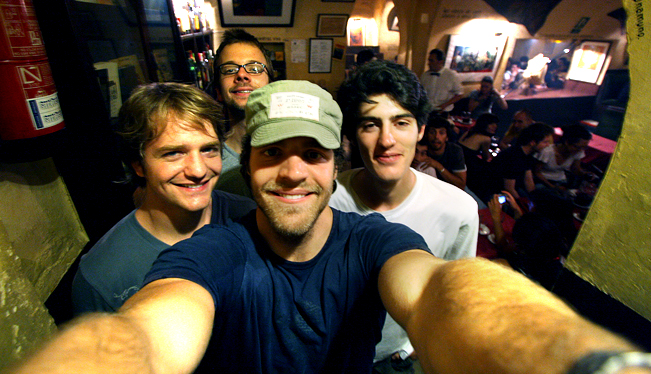So a new day. That night we planned to get a sleeper car to Paris, so we headed to the train station to get the tickets. Except they only had two spaces left on that sleeper train. And we had to sit in the train station another hour waiting in line to buy tickets for the following evening. This meant that we basically had two more days in Barcelona. This was good and bad. At worst we had lost a couple days on our schedule. At best we gained a chance to actually enjoy Barcelona. Joey booked a hotel in the city center, we checked in our bags, and headed out to enjoy the city.
Our first stop was the Sagrada Familia Temple, an architectural masterpiece that is still under construction after more than one hundred years. I considered seeing a cathedral while it was under construction a great gift. I’ve always been overwhelmed with the beauty of cathedrals, and I could never understand how they were built. I couldn’t believe that medieval man could persevere in the construction of something so cohesively beautiful, so harmonious in construction, so massive, so overwhelming in scope and purpose. To me the best cathedrals are seamless. They feel like light filled caverns carved out of hulking pieces of marble. To see in the present moment workers piecing together columns of marble, to watch them climb scaffolding to carve out the ceiling, to see the construction of something that seems timeless, helped me see the collaboration, the shared vision necessary to achieve the desired end.
Much of the cathedral is complete, and for me the most affecting part of the cathedral is the Passion Portal. Featuring sculptures by Sabiruchs, the portal depicts the final hours of the life of Christ. The sculptures themselves are blocky and weighty; it is almost as if you can see gravity pulling them down. The weight of the sculptures communicates the pathos of the scene itself—here the innocent Christ suffers willingly at the hands of vindictive man.
Each scene is powerful, but it is the centerpiece that pulls the entire portal together for me. At the center of the portal is Christ himself, bound to a column, weary and bloody from Roman lashes, and on the door behind him in gold letters Pilate’s infamous question to Christ, “What is truth?” glitters in the afternoon sun.
What is truth? These sculptures, all art really, attempts to answer that question.
Keats famously wrote that truth is beauty and beauty is truth, which at least means that we experience truth by experiencing beauty and that we experience beauty by experiencing truth. In many ways I agree with Keats. There is most certainly a relationship between truth and beauty, because our voracious appetite for beauty indicates that there is something more than aesthetic appreciation going on when we experience something beautiful. But I can’t go all the way with Keats. As N. T. Wright argues in Simply Christian, I think beauty is an echo of truth; beauty is not truth itself—it is something that indicates there is truth. In the same way that an echo is not a voice, beauty is not truth. But when I see something like the Passion Portal, that echo resonates more strongly, and I know that truth is afoot.
I love travel because I think travel teaches us how to keen our ears to that echo, and it is important to find that echo. It reminds us that there is someone speaking.
There is a Voice.
I’ve been meditating on Psalm 29 for the last few weeks. In it King David enumerates the many ways in which God’s voice is powerful. One of my favorites is, “The voice of the Lord is over the waters.” For me this image hearkens back to creation, when God’s spirit was over the waters of the earth, waiting to burst forth in creative power. When that voice speaks, it does echo throughout the cosmos. “The heavens declare the glory of God” mostly because they still vibrate with the power of His voice. So what about art? The feeble work of our hands—our paintings, our sculptures, our buildings, and our words—are echoes of an echo, and even the echo of an echo points back to the Voice.
For more pictures, visit Joseph’s website.























